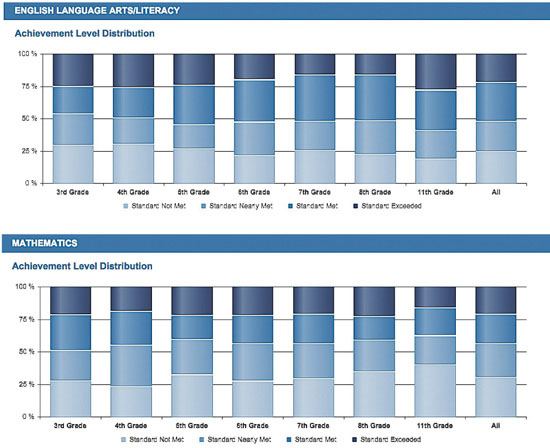|
|
Published October 7th, 2015
|
Old Test, New Test: Lamorinda Schools Land on Top
|
|
| By Sophie Braccini |
|
|
 |
When real estate values and desirability are driven by local schools' performances, state test results and the schools' Academic Performance Index (API) can have a monetary impact on a community. So, when the state changed the rules of the testing game, people took notice.
 Fortunately the September results from the California Assessment of Student Performance and Progress system were positive, with Lamorinda schools' test scores among the highest in Contra Costa County and the state. CAASPP was signed into law in October 2013 through Assembly Bill 484 to replace the Standardized Testing and Reporting (STAR) program.
Fortunately the September results from the California Assessment of Student Performance and Progress system were positive, with Lamorinda schools' test scores among the highest in Contra Costa County and the state. CAASPP was signed into law in October 2013 through Assembly Bill 484 to replace the Standardized Testing and Reporting (STAR) program.
 The new CAASPP measures how students have assimilated the new Common Core standards that the school districts have been implementing for the past three years. "This was the first administration of the new test and it will be our baseline," said Carolyn Parker, Ph.D., the Moraga School District's director of curriculum and instruction. "Our students did an excellent job and we are very proud of them."
The new CAASPP measures how students have assimilated the new Common Core standards that the school districts have been implementing for the past three years. "This was the first administration of the new test and it will be our baseline," said Carolyn Parker, Ph.D., the Moraga School District's director of curriculum and instruction. "Our students did an excellent job and we are very proud of them."
 In the Moraga School District, 84 percent of students met or exceeded the English language arts/literacy standard and 80 percent of students met or exceeded the mathematics standard, while the Lafayette School District stood at 82 percent and 80 percent, the Orinda Union School District at 87 percent and 83 percent, and the Acalanes Union High School District at 85 and 70 percent, respectively. In California, 44 percent of students in all grades met or exceeded the English language arts/literacy standard and 33 percent met or exceeded the mathematics standard.
In the Moraga School District, 84 percent of students met or exceeded the English language arts/literacy standard and 80 percent of students met or exceeded the mathematics standard, while the Lafayette School District stood at 82 percent and 80 percent, the Orinda Union School District at 87 percent and 83 percent, and the Acalanes Union High School District at 85 and 70 percent, respectively. In California, 44 percent of students in all grades met or exceeded the English language arts/literacy standard and 33 percent met or exceeded the mathematics standard.
 The new test was quite different in format and in content than STAR. "The old test consisted of filling in bubbles on sheets of paper. This time, all the tests were taken on computers and students had to write narratives in some parts of the test," explained Parker. CAASPP requires the students to manipulate information, analyze problems and demonstrate how they reached a conclusion. The good scores are therefore also the result of a more intensive and systematic preparation of the students using technology in the classroom, as well as mastering core standard concepts.
The new test was quite different in format and in content than STAR. "The old test consisted of filling in bubbles on sheets of paper. This time, all the tests were taken on computers and students had to write narratives in some parts of the test," explained Parker. CAASPP requires the students to manipulate information, analyze problems and demonstrate how they reached a conclusion. The good scores are therefore also the result of a more intensive and systematic preparation of the students using technology in the classroom, as well as mastering core standard concepts.
 "Last year the district started a K-2 computer program, knowing this test was coming," said MSD Superintendent Bruce Burns. The test was administered to third through eighth graders and to 11th graders.
"Last year the district started a K-2 computer program, knowing this test was coming," said MSD Superintendent Bruce Burns. The test was administered to third through eighth graders and to 11th graders.
 "The principals will be working with their staff to analyze the results and set instructional goals to focus what they want this year with their students," added Parker.
"The principals will be working with their staff to analyze the results and set instructional goals to focus what they want this year with their students," added Parker.
 At Camino Pablo Elementary, Principal Tom Rust has started the analysis, working with teams of parents and teachers. "The biggest thing is how well our kids did, and we are celebrating it," said Rust. "In a lot of places the test (results) took a dip. We are very proud of how our students did." Rust said that the test results allow the team to focus on areas that appear to be relatively weak. "For example, there are four sub-categories in English proficiency, and it appears that the listening section for English learner students was a little lower," he said. "The math testing had three sub-categories and we will end up looking at the problem solving part."
At Camino Pablo Elementary, Principal Tom Rust has started the analysis, working with teams of parents and teachers. "The biggest thing is how well our kids did, and we are celebrating it," said Rust. "In a lot of places the test (results) took a dip. We are very proud of how our students did." Rust said that the test results allow the team to focus on areas that appear to be relatively weak. "For example, there are four sub-categories in English proficiency, and it appears that the listening section for English learner students was a little lower," he said. "The math testing had three sub-categories and we will end up looking at the problem solving part."
 The focus, noted Burns, is not about teaching to the test, but that since this new test is more relevant, it is a very useful tool. "The core standards are more rigorous and challenging," said Burns. "(The CAASPP) is different because we are asking kids to take skills that they should know and apply them, to use critical thinking to arrive at solutions to the problems they are being asked." Parker adds that the test is also adaptive to children, which makes a big difference.
The focus, noted Burns, is not about teaching to the test, but that since this new test is more relevant, it is a very useful tool. "The core standards are more rigorous and challenging," said Burns. "(The CAASPP) is different because we are asking kids to take skills that they should know and apply them, to use critical thinking to arrive at solutions to the problems they are being asked." Parker adds that the test is also adaptive to children, which makes a big difference.
 The CAASPP website includes test results and also has a video for parents to help them understand the information that was sent to them. "This is one snapshot in time, and we also look at report cards, teacher's information, quizzes, tests, to paint a picture of a child overall performance," assured Burns.
The CAASPP website includes test results and also has a video for parents to help them understand the information that was sent to them. "This is one snapshot in time, and we also look at report cards, teacher's information, quizzes, tests, to paint a picture of a child overall performance," assured Burns.
 At this time the State has not released the new APIs for Lamorinda schools, but it is likely to come with a new formula that the community will be scrutinizing. "The State is looking into incorporating other data points such as attendance rate and graduation rate to paint a more well-rounded representation of a school district," said Burns.
At this time the State has not released the new APIs for Lamorinda schools, but it is likely to come with a new formula that the community will be scrutinizing. "The State is looking into incorporating other data points such as attendance rate and graduation rate to paint a more well-rounded representation of a school district," said Burns.
 To view the CAASPP test results, visit www.caaspp.cde.ca.gov.
To view the CAASPP test results, visit www.caaspp.cde.ca.gov.

|
|
|
|
|
|
|
|
|
| |
|
|
|
|




